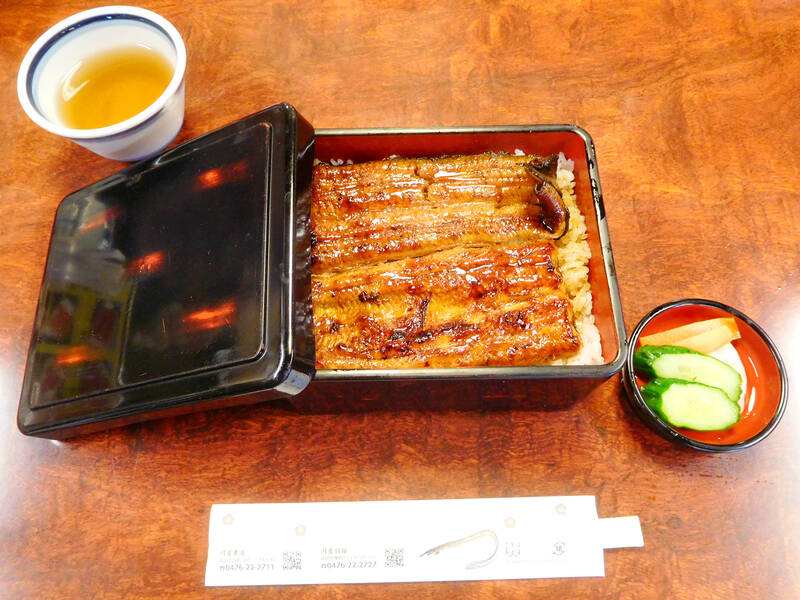Donburi, often simply called don, is a beloved Japanese dish that consists of a bowl of steamed rice topped with various other ingredients. The word donburi itself actually means “bowl” in Japanese, but it has come to represent much more than just a vessel.
Donburi first emerged during the Edo period (1603–1867) as a quick and convenient meal for busy city dwellers. By the 19th century, donburi had become immensely popular among theater enthusiasts, who often purchased these portable meals to enjoy during long performances. Una-don, a donburi topped with grilled eel, was a particular favorite. Easy-to-carry and satisfying, it made the perfect dish for theatergoers and enabled them to enjoy a hearty meal without leaving their seats.
Today, donburi can be made with a wide range of ingredients to suit all tastes and seasons. Some versions are topped with raw fish, such as kaisen-don (seafood bowl), while others might feature tempura, vegetables, or beef. One popular modern variation is katsu-don, which features a breaded and deep-fried pork cutlet. In Japan, katsu-don is associated with good luck, since the local word for pork cutlet, tonkatsu, contains katsu, which also means “victory.” It’s thus a common belief that eating katsu-don before an important exam will bring success.

Photo from Wikimedia / 照片:維基共享資源提供
Apart from all this flavor and good fortune, donburi’s enduring appeal lies in its versatility and its deep cultural roots. With countless variations to explore, it remains a timeless staple of Japanese cuisine, offering a delicious glimpse into the heart of Japanese culture.
丼飯(通常簡稱為「丼」)是一種深受喜愛的日本料理,由一碗蒸飯搭上各種其他食材所組成。丼飯這個詞本身在日文中意指「碗」,但現在它代表的意義遠超過一個容器。
丼飯最早出現在江戶時代(西元1603至1867年),作為忙碌都市居民的一種快捷方便的餐食。到了19世紀,丼飯在劇院愛好者中變得極為流行,他們經常購買這種便攜的餐點,以便在長時間的演出中享用。鰻魚丼是上面放著烤鰻魚的丼飯,是其中一種特別受歡迎的丼飯。這道料理易於攜帶且令人滿足,是劇院觀眾的完美選擇,使他們能在不離開座位的情況下享受一頓豐盛的餐點。
如今,丼飯可以用多種不同的食材製作,適合各種口味和季節。有些版本以生魚片為頂料,例如海鮮丼,而其他版本可能搭配天婦羅、蔬菜或牛肉。其中一種受歡迎的現代變體是炸豬排丼,其特點是用麵包粉裹著的炸豬排。在日本,炸豬排丼與好運有關,因為當地對於豬排的稱呼tonkatsu中的katsu也有「勝利」的意思。因此,人們普遍相信在重要考試前吃炸豬排丼會帶來成功。
除了美味和好運,丼飯的持久魅力還在於它的多樣性和深厚的文化根基。隨著無數變化可以探索,它依然是日本料理中一道永不過時的主食,為人們提供了一窺日本文化精髓的美味體驗。
MORE INFORMATION
the Edo period (日本)江戶時代
dweller n. 居民
theatergoer n. 劇院觀眾
hearty adj. 豐盛的
breaded adj. 裹麵包粉的
cutlet n. 排骨;肉排
versatility n. 靈活性;多功能性
Key Vocabulary
1. beloved adj. 受鍾愛的;深愛的
Holly still keeps her beloved childhood teddy bear on her bed.
荷莉仍然將她深愛的童年泰迪熊放在床上。
2. ingredient n. 食材;成分
Learning how to combine different ingredients is the key to becoming a great cook.
學會如何搭配不同的食材是成為優秀廚師的關鍵。
3. emerge vi. 出現;浮現
New trends in technology emerge every year, changing the way people live and work.
每年都有新的科技趨勢出現,改變人們的生活和工作方式。
4. portable adj. 輕便的;便攜的
making it easy to carry to meetings.
這台筆電輕巧便攜,方便帶去開會。
5. grill vt. 燒烤
Tom loves to grill steaks on the weekends when his friends come over.
湯姆喜歡在週末朋友來訪時燒烤牛排。
6. version n. 版本
The museum displayed an early version of the artist’s famous painting, showing how the work evolved.
博物館展出了這位藝術家著名畫作的早期版本,展示了作品的演變過程。
7. variation n. 變體;變化
The chef created a new variation of the dish by adding fresh herbs and spices.
這位廚師藉由加入新鮮香草和香料創造了菜餚的變化。
8. enduring adj. 歷久不衰的;耐久的
The enduring beauty of the ancient temple continues to attract visitors from around the world.
這座古廟歷久不衰的美麗仍然吸引著來自世界各地的遊客。
9. staple n. 主要部分;主食
Fish is a staple of the diet in coastal towns, where it is always fresh and abundant.
魚是沿海城鎮飲食的主要部分,那裡的魚總是新鮮且豐富。
學習音檔: https://magazine.english4u.net/Magdata/menu/dhkt1
《空中美語》雜誌APP免費下載: https://www.english4u.net/apps/index.aspx
免費收聽當月《空中美語》雜誌課文朗讀及解析 !
文章由AMC空中美語授權使用: https://www.english4u.net

Computex, Asia’s biggest electronics conference, kicked off Monday in Taipei, and as in years past drew industry chieftains from Nvidia Corp.’s Jensen Huang and Qualcomm Inc.’s Cristiano Amon to Young Liu of Foxconn, which makes the bulk of the world’s iPhones and Nvidia servers. But while last year’s event was a celebration of the post-ChatGPT AI boom, executives this time are likely grappling with the uncertainty of the Trump administration’s effort to reshape the global trade order — disrupting a decades-old model for tech manufacturing. This year’s exhibition will of course feature the hardware required to bring artificial intelligence to life.

For many people, allergies are an all-too-familiar annoyance. The constant sneezing, itching, and watery eyes are just a few clear signs of allergies, which is a surprisingly common condition affecting millions worldwide. But what exactly triggers these reactions, and how can we cope with them? Allergies arise from a misunderstanding between our immune system and seemingly harmless substances. Under normal circumstances, the immune system acts as our body’s personal bodyguard, diligently identifying and eliminating threats like viruses and bacteria. However, in individuals with allergies, the immune system mistakenly identifies certain substances, called allergens, as invaders. This triggers a reaction, leading to

A: South Korean supergroup BTS member J-Hope, EXO member Xiumin and other various artists are set to tour Taiwan. B: Is J-Hope the first BTS member to visit as a solo singer? A: Yup, he’s going to stage two shows in Taoyuan over the weekend. B: All BTS fans, nicknamed “ARMY,” must be so happy. I wonder when the seven-member group can finally stage a comeback again. A: Well, the good news is the five members currently performing military service will all leave the army next month. So the fans’ long wait is about to end. A: 南韓天團防彈少年團BTS的J-Hope,和EXO的Xiumin等多位熱門歌手最近都要來台開唱。 B:

1. 眾所皆知,資訊產業是我國經濟的基礎。 ˇ As everyone admits, the IT industry is the backbone of our economy. χ As everyone admits that the IT industry is the backbone of our economy. 註:這裏 as 作關係代名詞,引導從屬子句。誤句多了 that, IT industry is. . . 就變成從屬句,欠缺了主句,結構上錯誤。又如: As my friend pointed out, necessity is the mother of invention. As is known to all, grammar is not the only important thing in language study. 2. 她心情總是非常好。 ˇ She is always in a good mood. χ She always is in a good mood. 註:always, often 一般放在行為動詞之前,連繫動詞、助動詞之後: He always behaves well. He is always happy and gay. He is always reading. 其他用法類似的副詞,還有 still、also、hardly、seldom、never 等。 3. 你看!他還在寫報告呢。 ˇ Look! He is still working